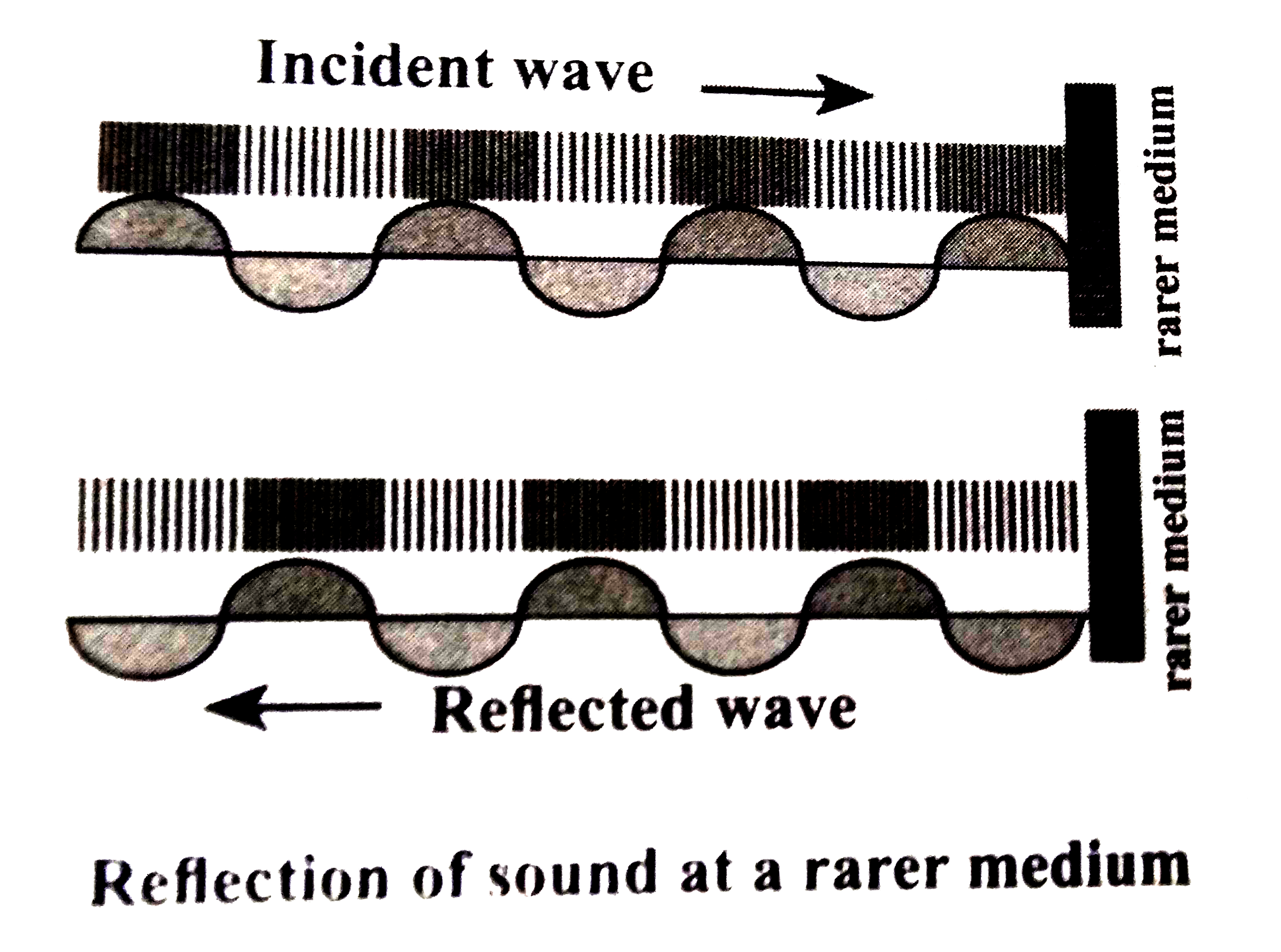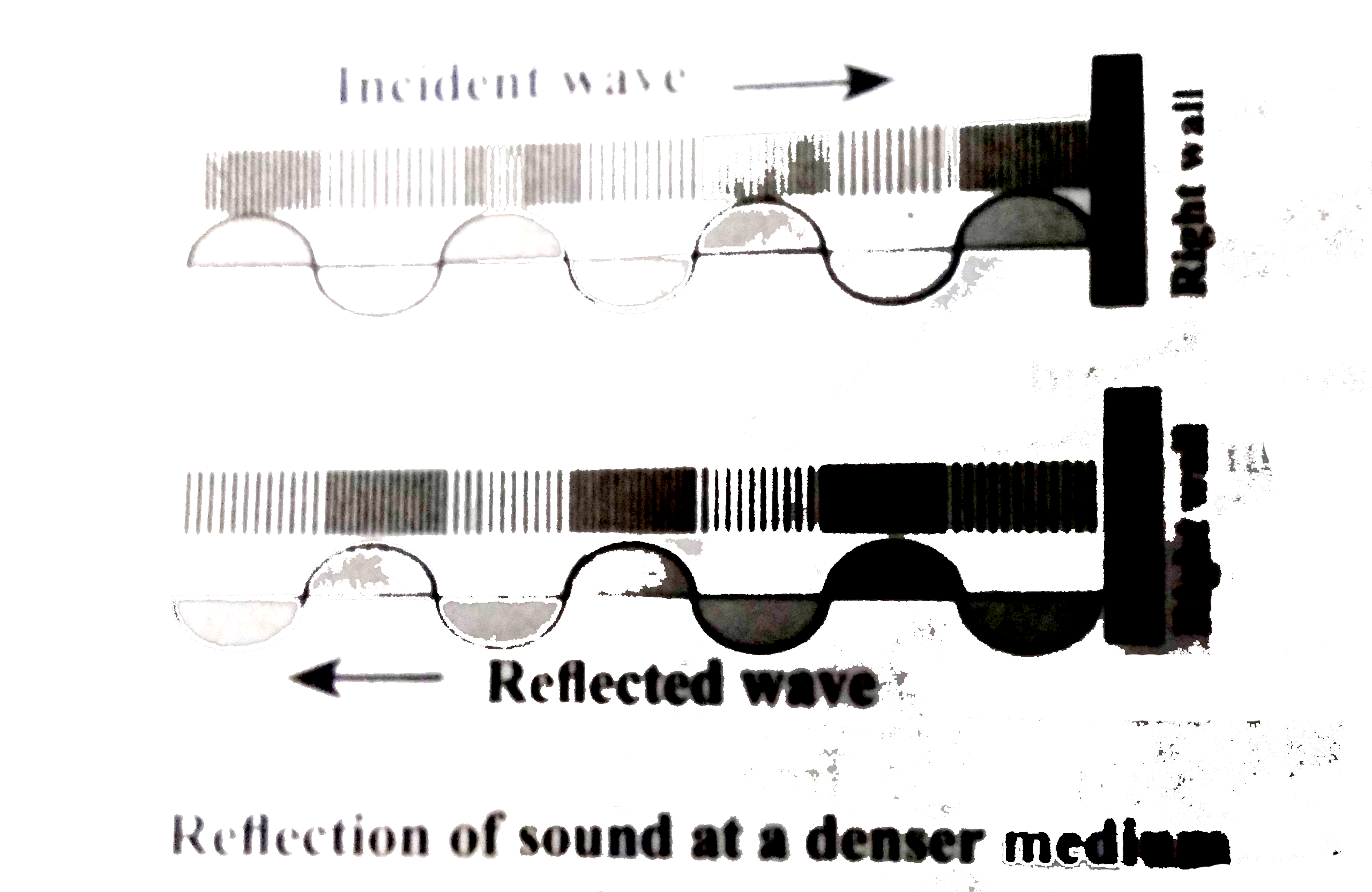What is mean by rellection of sound? Explain.
(a) Reflection at the boundary of a rarer medium
(b) Reflection at the boundary of a denser medium
(c) Reflection at sound in curved surfacesSolution in Tamil
Reflection of Sound:
The bouncing of sound waves from the interface between two media is termed as the reflection of sound.
(i) Consider a wave travelling in a solid medium striking on the interface between the solid and the air. The compression exerts a force F on the surface of the rarer medium.
(ii) As a rarer medium has smaller resistance for any deformation, the surface of separation is pushed backwards.
(iii) As the particles of the rarer medium are free to move, a rarefaction is produced at the interface. Thus, a compression is reflected as a rarefaction and a rare faction travels from right to left.

(i) A longitudinal wave travels in a medium in the form rarefactions. Suppose a of compressions and left to right reaches a rigid wall.
(ii) The compression exerts a force F on the rigid wall. In turn, the wall exerts an equal and opposite reaction R=- F on the air molecules. This results in a compression near the rigid wall.
(iii) Thus, a compression travelling towards the rigid wall is reflected back as a compression. That is the direction of compression is reversed.

(i) When the sound waves are reflected from the curved surfaces, the intensity of the reflected waves is changed.
(ii) When reflected from a convex surface, the reflected waves are diverged out and the intensity is decreased.
(iii) When sound is reflected from a concave surface, the reflected waves are converged and focused at a point. So the intensity of reflected waves is concentrated at a point.
(iv) Parabolic surfaces are used when it is required to focus the sound at a particular point. Hence, many halls are designed with parabolic reflecting surfaces.
(v) In elliptical surfaces, sound from one focus will always be reflected to the other focurs, no matter where it strikes the wall.
Topper's Solved these Questions
- BOOK - FULL MARKSCHAPTER - ACOUSTICSEXERCISE - TEXTUAL EVALUATION (X. HOT Questions )2videos
ACOUSTICS
- BOOK - FULL MARKSCHAPTER - ACOUSTICSEXERCISE - Additional Questions (I. Choose the best answer)6videos
ACOUSTICS
- BOOK - FULL MARKSCHAPTER - ACOUSTICSEXERCISE - TEXTUAL EVALUATION (VIII. Problem Corner)7videos
ACOUSTICS
- BOOK - FULL MARKSCHAPTER - DEPARTMENTAL MODEL PAPER (SOLVED)EXERCISE - PART-IV6videos
DEPARTMENTAL MODEL PAPER (SOLVED)
Similar Questions
Suppose that a sound wave and a light wave have the same frequency, then which one has a longer wavelength?
03:35View SolutionLight can travel in a vaccum but not sound because ...........
03:19View SolutionA sound wave has a frequency of 200 Hz and a speed of 400ms−1 in a medium. Find the wavelength of the sound wave.
05:01View SolutionExplain the experiment of measuring the real and apparent expansion of a liquid with a neat diagram.
04:06View SolutionA sound waves passes from a medium A to a medium B. The velocity of sound in B is greater than in A. Assume that there is no absorption or reflection at the boundary . As the wave moves across the boundary :
01:04View SolutionWhat happens to a particle velocity when a sound wave is reflected from a rarer medium and a denser medium ?
08:52View SolutionWhen sound waves are reflected from a denser medium
05:01View SolutionExplain the reflection of transverse and longitudinal waves from a denser and a rarer medium.
06:00View SolutionIf sound waves reflected from the denser medium, then there is
02:43View SolutionWhen sound is reflected from a denser medium
04:21View SolutionWhen sound waves are reflected from a denser medium
03:26View SolutionWhen sound is reflected from a denser medium,
04:12View SolutionA : If a wave moving in a rarer medium , gets reflected at the boundary of a denser medium , then it encounter a sudden change in phaso or pi . R : If a wave propagating in a denser medium , gets reflected from rarer medium , then there will be no abrupt phase change .
03:12View SolutionA sound wave passes from a medium A to a medium B. The velocity of sound B is greater than that in A. Assume that there is no absorption or reflection at the boundary. As the wave moves across the boundary
01:42View SolutionWhen sound is reflected from a denser medium,
02:58View Solution

